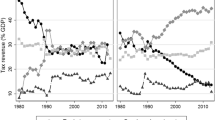Abstract
Measuring the effects of taxation on FDI in developing countries requires consideration of the tax sparing provision. This provision signed between developed and developing countries protects host country fiscal incentives for FDI. This paper estimates the impact of tax sparing provisions on Japanese outbound FDI between 1989 and 2000. We find evidence that the tax sparing provision influences positively the location of Japanese FDI, even after having taken into account reversal causality.
Similar content being viewed by others
References
Alastair, H., Rudebush, G., & Wilcox, D. (1996). Judging instrument relevance in instrumental variables estimation. International Economic Review, 37(2), 283–298.
Arase, D. (1993). Japanese policy toward democracy and human rights in Asia. Asian Survey, 33, 935–952.
Baltagi, B. (1981). Simultaneous equations with error components. Journal of Econometrics, 17, 189–200.
Baltagi, B. (2001). Econometric Analysis of Panel, Data New York: John Wiley and Sons.
Baltagi, B., & Wu, P. (1999). Unequally spaced panel data regressions with AR(1) disturbances. Econometric Theory, 15, 814–823.
Blonigen, B., & Wang, M. (2005). Inappropriate pooling of wealthy and poor countries in empirical FDI studies. In T. Graham, E. Moran, & M. Blomstrom, (Eds.), Does Foreign Direct Investment Promote Development?.
Blonigen, B., & Davies, R. (2004). The effects of bilateral tax treaties on U.S FDI activity. International Tax and Public Finance, (11), 601–622.
Boskin, M., & Gale, W. (1987). New results on the effects of tax policy on the international location of investment. In M. Feldstein (Ed.), The Effects of Taxation on Capital Accumulation.
Bound, J., Jaeger, D., & Baker, R. (1995). Problems with instrumental variables estimation when the correlation between the instrument and the endogenous explanatory variable is weak. Journal of the American Statistical Association, 90(430), 443–450.
Collier, P., & Gunning, J. (1999). Explaining African economic performance. Journal of Economic Literature, 37(1), 64–111.
Cummins, J., & Hubbard, G. (1995). The tax sensitivity of foreign direct investment: evidence from firm-level panel data. In M. Feldstein (Ed.), The Effects of Taxation on Multinational Corporations.
Davidson, R., & MacKinnon, J. (1993). Estimation and Inference in Econometrics. New York: Oxford University Press.
Devereux, M., & Freeman, H. (1995). The impact of tax on foreign direct investment: empirical evidence and the implications for tax integration schemes. International Tax and Public Finance, 2(1), 85–106.
Devereux, M., & Griffith, R. (1998). Taxes and the location of production: evidence from a panel of US multinationals. Journal of Public Economics, 68, 335–367.
Devereux, M., & Griffith, R. (2002). The impact of corporate taxation on the location of capital: a review. Swedish Economic Policy Review, 9, 79–102.
Easterly, W., & Levine, R. (1997). Africa’s growth tragedy: policies and ethnic divisions. Quarterly Journal of Economics, 112(4), 1203–1250.
Fink, C., & Kenny, C. (2003). W(h)ither the digital divide?. The Journal of Policy, Regulation and Startegy for Telecommunications, 5(6).
Forestier, E., Grace, J., & Kenny, C. (2002). Can information and telecommunications technologies be pro-poor?. Telecommunications Policy, 26, 623–646.
Grubert, H., & Mutti, J. (1991). Taxes, tariffs and transfer pricing in multinational corporate decision making. Review of Economics and Statistics, 73(2), 285–283.
Hartman, D. (1984). Tax policy and foreign direct investment in the United States. National Tax Journal, 37(4), 475–488.
Head, K., Ries, J., & Swenson, D. (1995). Agglomeration benefits and location choice: evidence from Japanese manufacturing investments in the United States. Journal of International Economics, 38(3–4), 223–247.
Hines, J. (1996). Altered states: taxes and the location of foreign direct investment in America. American Economic Review, 86(5), 1076–1094.
Hines, J. (1996). Lessons from behavioral responses to international taxation. National Tax Journal, 52(2), 305–322.
Hines, J. (2001). Tax sparing and direct investment in developing countries. In Hines James (Ed.), International Taxation and Multinational Activity.
Hines, J., & Rice, E. (1994) Fiscal paradise: foreign tax havens and American business. Quarterly Journal of Economics, 109(1), 149–182.
Kawai, M., & Takagi, S. (2001). Japan’s official development assistance: recent issues and future directions. World Bank Policy Research Working Paper, 2722.
Lehmann, A. (2002). Foreign direct investment in emerging markets: income, repatriations and financial vulnerabilities. IMF Working Paper, WP/02/47.
Mooij, R., & Ederveen, S. (2003). Taxation and foreign direct investment: a synthesis of empirical research. International Tax and Public Finance, 10(6), 673–93.
Murthy, V. (1989). The effects of taxes and rates of return on foreign direct investment in the United States: some econometric comments. National Tax Journal, 42(4), 205–207.
Newlon, T. S. (1987). Tax policy and the multinational firm’s financial policy and investment decisions. Ph.D dissertation. Princeton: Princeton University.
OECD. (1998). Tax Sparing, A Time for Reconsideration. OECD Publications.
Rama, M., & Artecona, R. (2002). A database of labor market indicators across countries. Washington: World Bank, Development Reasearch Group.
Sargan, D. (1958). The estimation of economic relationships using instrumental variables. Econometrica, 26, 393–415.
Slemrod, J. (1990). Tax effects of foreign direct investment in the United States: evidence from cross-country comparison. In R. Assaf and J. Slemrod (Eds.), Taxation in a Global Economy, Chicago University Press.
Toaze, D. (2001). Tax sparing: good intentions, unintended results. Canadian Tax Journal, 49(4), 879–924.
Wheeler, D., & Mody, A. (1992). International investment location decisions. Journal of International Economics, 33, 57–76.
Young, K. (1988). The effects of taxes and rates of return on foreign direct investment in the United States. National Tax Journal, 41(1), 109–121.
Author information
Authors and Affiliations
Corresponding author
Additional information
JEL Classification F23 · H25 · H32
We Thank Michael Devereux, Edward Graham, Robert Lipsey, David Margolis, Claudia Rivas, Deborah Swenson, anonymous referees and seminar participants at the Franco-Korean conference in Seoul, and at the Western Economic Association conference in Vancouver for helpful discussions.
Rights and permissions
About this article
Cite this article
Azémar, C., Desbordes, R. & Mucchielli, JL. Do tax sparing agreements contribute to the attraction of FDI in developing countries?. Int Tax Public Finance 14, 543–562 (2007). https://doi.org/10.1007/s10797-006-9005-9
Published:
Issue Date:
DOI: https://doi.org/10.1007/s10797-006-9005-9




